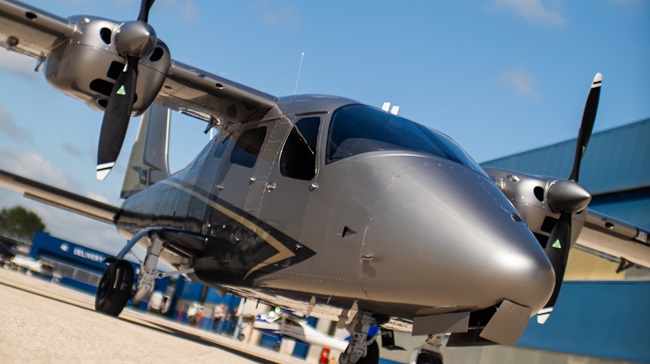Photography by Mike Collins
With its rounded lines and roly-poly looks, the Ercoupe looks like it would be right at home with a smiley face painted on its nose. And why not? The Ercoupe is one of the simplest, easiest, safest, and most fun airplanes you could want. It's also among the least expensive to buy and fly on the used market today and, despite its age, has a robust parts and owner support network. Some 2,400 Ercoupes are on the FAA registry, and some of them will sell for as low as $10,000 to $18,000. That’s quite a bargain, especially when you consider that earlier Ercoupes qualify for operation under Light Sport Aircraft rules. That means you can fly them without needing a medical certificate, and can qualify to perform much of the maintenance.
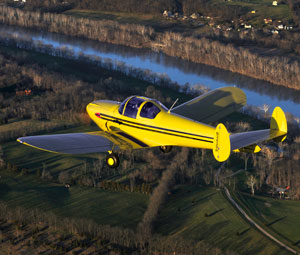 The Ercoupe story
The Ercoupe story
You can’t talk about Ercoupes without knowing a bit of history. The airplane originated way back in 1939, when famed designer Fred Weick penned it to win a safety contest. Back then, general aviation had a miserable safety record. Fatal stalls dogged the light airplanes of the day, as did botched crosswind landings and ground loops. Weick gave his Ercoupe tricycle landing gear and trailing-link main gear to help make challenging landings tamer, and he limited elevator up-travel to help reduce the potential for a stall. To keep his new two-seater in effortless coordinated flight, Weick did away with rudder pedals and interconnected the ailerons to the rudders, which were mounted in an “H” configuration at the ends of the horizontal stabilizer. The result was an airplane that couldn’t be stalled, couldn’t be cross-controlled, and therefore couldn’t be spun. The auto-steering and trailing link gear prompted the airplane’s first manufacturer to recommend landing the ’Coupe in a wings-level crab as a technique for dealing with crosswinds. For braking, there was a single, floor-mounted brake pedal, just like the one in your car.
The Engineering and Research Corporation (hence the “Erco” in the name) built the first 112 Ercoupes from 1939 to 1941. These airplanes had 65-horsepower Continental C-65 engines. But the hands-down, all-time boom year for Ercoupe sales was in 1946, when a whopping 4,309 75-horsepower, C-75-powered Ercoupe 415-C models rolled out of the factory in Riverdale, Maryland—right next to the historic College Park Airport. To this day, the 1946 415-C dominates the market.
The idea was that thousands of World War II pilots would want an airplane of their own after leaving the military. That may have taken care of the 1946 model year, but the bust came the following year, when only 77 Ercoupes were sold. And the Ercoupe never really recovered from this cataclysmic fall. Erco ended production in 1950. The Forney Aircraft Company of Fort Collins, Colorado, picked up the design in 1958 and built 163 Ercoupes until 1959, calling them Fornair F–1s. Then Alon Inc. of McPherson, Kansas, built 297 airplanes from 1965 to 1968. The Mooney Aircraft Company bought the Ercoupe in 1968 and ended its involvement in 1970, having sold 59 of what it called the Mooney M–10 Cadet—a 90-horsepower model with the signature, forward-swept single Mooney vertical stabilizer.
Univair Aircraft Corporation bought the Ercoupe type certificate in 1974 and to this day provides parts and other support for the airplane. But the airplane itself is out of production.
’Coupe flying
Dr. Gene Olinger bought his Ercoupe—a 1946 415-C, serial number 4064, built on October 10, 1946—as his first airplane. It’s the airplane featured in the accompanying photography. Since buying it in 2004, Olinger—a microbiologist based in Frederick, Maryland, at the U.S. Army’s Fort Detrick—has flown it about 300 hours, mostly for recreation. He bases N3439H at Frederick Municipal Airport, which is also AOPA’s home base. That made it easy to meet up with him and check out his vintage ’Coupe firsthand.
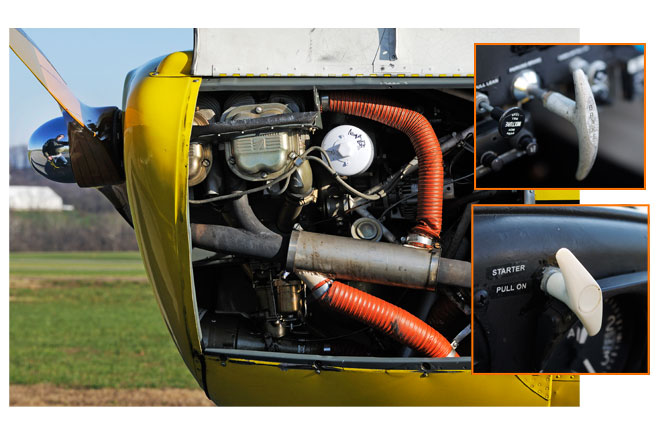
The Ercoupe's hinged cowl (above) opens wide to allow access to the Continental 85-horsepower engine. Like most Ercoupes flying today, this Ercoupe has had its stock, floor-mounted brake pedal assembly replaced with rudder pedals, so braking is via a panel-mounted brake control T-handle (top right). It serves double duty as both a parking brake and a brake for keeping taxi speed under control. Differential braking is not possible; it's either both wheel brakes or none. In this it's a foreshadowing of the early Piper Cherokee brake systems. Pull on another T-handle (bottom right) and you activate the starter.
In preparing for the flight I’d read the official instruction manual. It came from Univair and was a mere 21 pages worth of shockingly brief advice, compared to the pilot’s operating handbooks that come with today’s piston singles. I read the crosswind landing technique, and the paragraphs that advised 75 mph for liftoff and climb, and 60 to 70 mph for an approach speed. Then I saw the passage that affirmed that, yes, you could land the ’Coupe at up to twice the normal speed, no problem—as long as you kept forward pressure on the yoke, lest you inadvertently lift off. The manual was vague about cruise performance, but Olinger has an 85-horsepower Continental in his airplane and he said that 95 knots was the typical “high-speed” cruise, with power set at 2,400 rpm and a fuel burn of five gph.
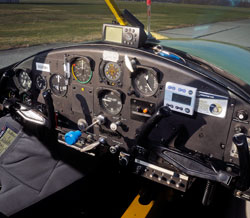 Gene Olinger's Ercoupe panel is a typical blend of original equipment and personalized, minimalist upgrades.
Gene Olinger's Ercoupe panel is a typical blend of original equipment and personalized, minimalist upgrades.
Soon enough, I was in the cockpit next to Olinger, and off we went. The big learning hurdle is to overcome the habits you pick up flying conventional airplanes, such as trying to steer using the rudder pedals (Olinger has the rudder-pedal retrofit, which is available for all 415-Cs). You brake using the panel-mounted brake/parking brake (the floor-mounted auto-style brake pedal having been removed) and must remember to use the control yoke to steer.
Runup was stone simple, as was the takeoff, which entailed applying full power, waiting for 65 mph, and pulling. Up we went to the tune of 500 fpm. In cruise, you just set power and enjoy the ride. And the view from the bubble canopy. There is a pitch-trim lever on the left sidewall, but the Ercoupe isn’t trim-hungry at all. I pushed the trim lever an inch forward, maybe, and that was that.
I’d flown Ercoupes before, and one cool thing is that you can lower the sides of the canopy and fly along with your arm resting on the window sill, the way you would in a car on a nice summer day. I’ve even heard that you can extend your arm into the slipstream, and effect a turn that way. Just be ready for the blast of air.
Landings? It was windy the day I flew, but no biggie. Reduce power, aim for 75 mph, hold that until you’re near the runway, then land and remember to steer with the control yoke! Crosswind? Go ahead and paste it on in a crab, Olinger swears. It’ll straighten right out.
Safety
The ads may say that Ercoupes are stallproof, but some say “not really.” Seems you can whip-stall the ’Coupe for a fast deceleration into a stall break. But it won’t stay stalled for long. Rudder-pedal Ercoupes can be cross-controlled to make a spin entry, but again, that entry won’t last long as the airplane rights itself, Ercoupe aficionados say. I’ve tried power-on and -off stalls, and all that happened was a mighty mush toward terra firma. But not a hint of a stall break.
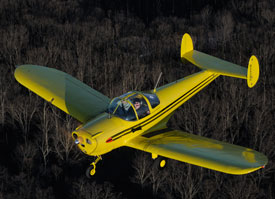 Which brings up the airplane’s safety record. There may be scant mention of stalls in the Ercoupe’s accident history, but there sure are a lot of steep descents to impact. Chop the power in an Ercoupe and you’ll see what I mean. As speed drops, so does the ship—alarmingly so when near the ground. So it may resist stalls, but it’s the king of level-attitude mushing at low power. The fact that Ercoupe manuals recommend an odd technique if you find yourself high on final and want to lose altitude should be a clue: “…The flight path may be steepened by rolling the airplane from side to side, dipping each wing 20 to 30 degrees. If the altitude is sufficiently high, this can be done satisfactorily with the wheel held full back and height is lost quite rapidly…” the Univair manual states. Yikes!
Which brings up the airplane’s safety record. There may be scant mention of stalls in the Ercoupe’s accident history, but there sure are a lot of steep descents to impact. Chop the power in an Ercoupe and you’ll see what I mean. As speed drops, so does the ship—alarmingly so when near the ground. So it may resist stalls, but it’s the king of level-attitude mushing at low power. The fact that Ercoupe manuals recommend an odd technique if you find yourself high on final and want to lose altitude should be a clue: “…The flight path may be steepened by rolling the airplane from side to side, dipping each wing 20 to 30 degrees. If the altitude is sufficiently high, this can be done satisfactorily with the wheel held full back and height is lost quite rapidly…” the Univair manual states. Yikes!
Sure, there’s a warning to regain airspeed for the flare by dropping the nose at about 200 feet agl, but if ever there was an endorsement to start a bad habit, there it is, right in the manual. No wonder there are so many mushing-descent accidents.
Gotchas
One word: corrosion. This is a big, big problem around the wing spar attach points, both on the wing side and the spar box center section. The worst corrosion seems to affect Ercoupes with metal wings (stock early-model airplanes came with fabric-covered wings) that have been sitting outside for a long time. Mouse urine—don’t laugh, it’s very acidic—has also been named as a culprit in corrosion. Obviously, hangaring the airplane does a lot to curtail the problem.
A lot of this corrosion wasn’t detected because early models didn’t have wing inspection panels. An airworthiness directive (AD 2002-26-02) mandates the installation of 16 inspection openings in the undersides of the wing so corrosion can be spotted. If it is, the wings must be replaced. Other ADs—virtually all of them relating to wear and corrosion—can be seen at Univair’s website.
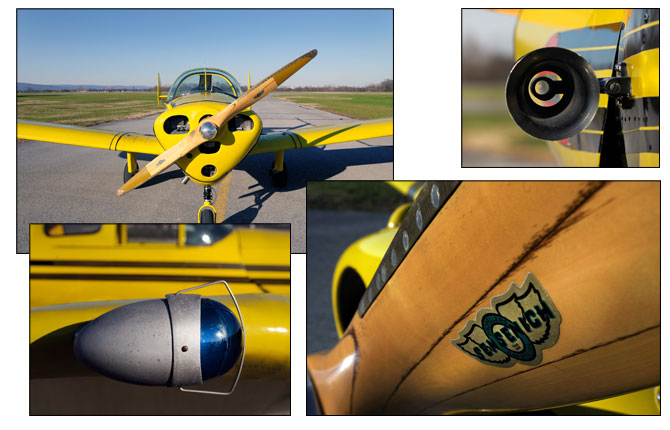
Many Ercoupe owners replace the stock metal propellers with Sensenich wood propellers (bottom right) to gain about 40 pounds of useful load. Vacuum for this model 415-C's heading indicator is supplied by ram air passing through a fuselage-mounted venturi tube (top right). Vintage touches include a master switch mounted behind the passenger seat and navigation lights secured by wire bails (bottom left).
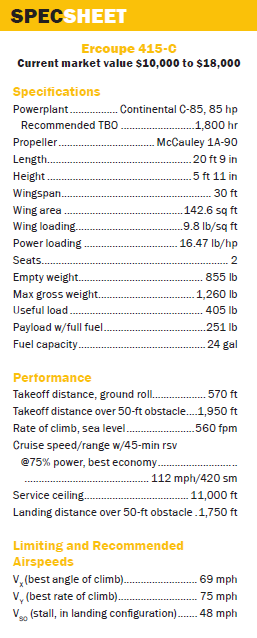 LSA capability
LSA capability
Only the 1940-41 and 1946 Ercoupe 415-C models qualify for flying under LSA rules. That’s because they are two-seaters with maximum gross weights of 1,260 pounds—well under the 1,320-pound limit, and their stall and cruise speeds also meet the LSA rules. This means that pilots working toward their sport pilot certificates can earn their tickets with as little as 20 hours of dual, and five hours of solo time in the Ercoupe 415-C. What’s more, under sport pilot rules you can use your driver’s license in place of an FAA third class medical certificate—as long as you haven’t had an FAA medical certificate denied, revoked, or suspended.
The only down side for sport pilot candidates earning their licenses in Ercoupes without rudder pedals is that their pilot certificates will carry a limitation saying “limited to flight in Ercoupes without rudder pedals.” Want to earn pilot privileges in a Skyhawk? Then it will be another checkride. Now you know why most Ercoupes have been retrofitted with rudder pedals. It’s something to consider if you’re thinking of buying an Ercoupe in which to earn a pilot certificate or build time.
Topping off the Ercoupe’s attributes is its type club—The Ercoupe Owners Club. It’s a good source of social and technical information for anyone interested in the airplane. See www.ercoupe.org for a look at its offerings.
As the airplane closes in on its seventy-second year, it’s somehow reassuring that it has retained its popularity for so long. Sure, detractors look down on it as not macho. Some have even blamed the abrupt post-1946 sales slump on its being too easy to fly—especially for veterans looking to fly the kind of fire-breathing taildraggers they knew from their military years. But sales slumps come and go.
Fred Weick’s Ercoupe may not be macho, but its appeal is being rediscovered by a new generation of recreational flyers looking for a mature, forgiving design capable of flying a cross-country, and letting you fly with the windows down. For less than $20,000.
Email the author at [email protected].
 The Mooney Mite
The Mooney Mite
The Mooney M–18 Mite is a contemporary of the Ercoupe, and 283 were built between 1948 and 1955. It was certified by Albert Mooney and Charles Yankey, and was the first airplane produced by Mooney Aircraft Inc. True to its name, the M–18 was tiny. Max gross weight was 850 pounds, max cruise speed was 108 knots, and the airplane was powered by a 65-horsepower Lycoming O-145 engine. The Mite had a fabric-covered wood airframe and could take off in as little as 300 feet. In 1953, the Mite was given the "Wee Scotsman" moniker—a play on the M–18's stellar economy. At two mph per horsepower and less than a penny per mile in operating costs, the Mite must surely hold a record in those departments. Only 166 Mites are flying today, and asking prices for a good M–18 range from $10,000 to $28,000. But for its retractable landing gear, the Mite would qualify for use under Light Sport aircraft rules. For more information, visit the website.

